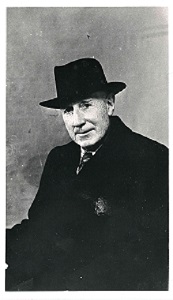TOMÁS BÁN AND HELENA CONCANNON

by Tom Kenny
Tomás Bán and his wife Helena were two people who made an outstanding contribution to the cultural enrichment of Galway and indeed of the country generally in the first half of the last century.
Tomás Bán was born on Inis Meáin on November 16th, 1870, the son of Páidín Concannon and his wife Annie Faherty. He was educated on the island and unusually for an islander, in the Monastery School in Galway. As a teenager, he was taken to the U.S. where he graduated with a MA in accountancy. He worked for a while in his brother’s vineyard in California, started a business in Mexico and it was there that he first began reading in the Irish language. He came back to Ireland in 1898 for a holiday but he became so immersed in the workings of the Gaelic League that he stayed and became their first ever organiser travelling the country at his own expense until they started paying him. He toured the U.S. in 1905 with Douglas Hyde on behalf of the League and they collected £20,000 for the cause. Tomás Bán worked in Monaghan until 1912 when he became a health inspector in Galway.
He took no part in the War of Independence apart from occasionally hiding people on the run.
He lived on Kingshill in Salthill with his wife Helena (they married in 1906) in a house known as “Lios na Mara”, a title give to it by his close friend Pádraic Pearse. Our photograph of the house was taken from the seashore. A Gaelic scholar, he wrote a number of books in the Irish Language and collaborated with Helena on several more. He was involved in the setting up of Scoil Fhursa. Though he retired in 1938, he devoted much of his life to the promotion of the Irish language. In 1958, he was conferred with an honorary LL.D degree by the N.U.I. in recognition of his remarkable work for the Irish Language. Among his publications were ‘Leabhar Cainte Béarla Gaeilge’ and “Seoda na Sean”. He was a close friend of De Valera who regularly stayed in his house. He died in 1961.

Helena Walsh Concannon was born in 1878 in Maghera in Co. Derry. She went to UCD and graduated with a M.A. from the Royal University. Her first published pieces were love poems to her husband. She became a professor of history in UCG and embarked on a literary career which won her international acclaim as an historian, a biographer and an authority on the lives of Irish saints. She was one of the first historians to focus in any way on women’s contribution to life in Ireland, won many awards and prizes for her work and in 1929 was conferred with a D. Litt by the National University for her outstanding contribution to historical knowledge. Among the twenty plus books she published were “Women of Ninety Eight”, ‘Daughters of Banba’, “The Poor Clares in Ireland” and ‘Irish Nuns in Penal Days’.
She was elected to the Dáil in 1933 for the University Constituency and served until 1937 when the University representation was abolished under the Constitution of that year. She became a member of the Seanad as senior representative of the N.U.I. and was one of the minority voices against the role appointed to women in Dev’s constitution. She died in 1952 and is buried with her husband in the New Cemetery.
She was a particularly good friend of her adopted city and her contributions to debates on Galway’s problems and western problems generally were masterly expositions of the subjects, and oratorically of a very high quality.

The Cocannons had, unusually in Salthill, a small orchard at the back of their house. Local children often went to the door in the hope of getting an apple. If one asked for an apple, please, one was politely refused. If one however, said “Ba mhaith liom úll, má’s é do thoil é”, one was likely to go home with several apples.
Shamefully, this couple have largely been forgotten today, maybe it is time the city honoured them in some way.
.png)